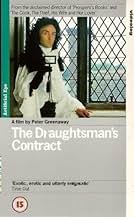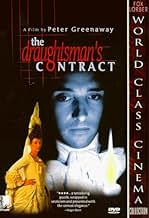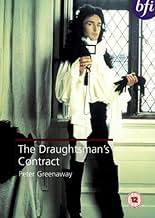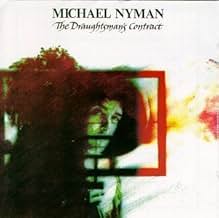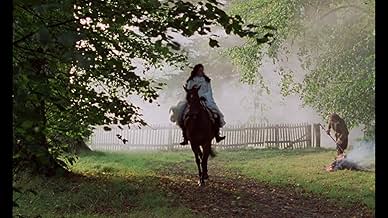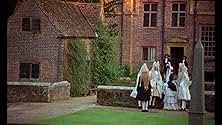NOTE IMDb
7,2/10
12 k
MA NOTE
Un jeune artiste est engagé par la femme d'un riche propriétaire terrien pour réaliser une série de dessins du domaine alors que son mari est absent.Un jeune artiste est engagé par la femme d'un riche propriétaire terrien pour réaliser une série de dessins du domaine alors que son mari est absent.Un jeune artiste est engagé par la femme d'un riche propriétaire terrien pour réaliser une série de dessins du domaine alors que son mari est absent.
- Réalisation
- Scénario
- Casting principal
- Récompenses
- 1 victoire et 4 nominations au total
Anne-Louise Lambert
- Mrs. Talmann
- (as Anne Louise Lambert)
Nicholas Amer
- Mr. Parkes
- (as Nicolas Amer)
Lynda La Plante
- Mrs. Clement
- (as Lynda Marchal)
Alastair G. Cumming
- Philip - Mr. Neville's assistant
- (as Alastair Cummings)
Avis à la une
Peter Greenaway's first commercially released feature film is a calling card of dazzling virtuosity.
Peter Greenaway's smart, outrageous, and utterly original historic movie is part comedy of manners and part murder mystery, as a late 17th century draughtsman (Anthony Higgins) is tasked with producing a series of drawings for the Herbert family estate by the lady of the manor (Janet Suzan) in order to please her husband, but he ends up pleasing himself with both Mrs Herbert and her daughter (Anne-Louise Herbert), before the husband is found dead in the moat and he becomes prime suspect in his murder. This was Greenaway's first conventional feature film, it shows him at his best and most playful, and is a calling card of dazzling virtuosity. The original cut ran in excess of three hours but was edited down to 103 minutes for release to make it easier to watch. It is still a puzzle box of a movie and a real strange delight though, featuring elaborate and slightly exaggerated (for eye catching effect) period costumes, a wonderful score by Michael Nyman which borrows widely from Henry Purcell, that reflects the period setting whilst managing to rock with a vengeance, and a 'living statue' that roams the garden unseen to all but children, it is a movie that you won't forget in a hurry. Incidentally, Greenaway trained as an artist before he became a filmmaker, and the hands seen drawing in the film are his own, as are the completed drawings.
Being of English origin the film has a particular fascination. Certain things become apparent if you know England well, but also I suspect on repeated viewing.
A tale of conceit, deception and power. The conceit of the Draughtsman, all too apparent, is matched by the conceit of the upper classes as the film unfolds. The pictoral conceit referred to in the film repeatedly is matched by a pictoral conceit played on the viewer: the wigs were never that big, the house, garden and grounds stunning and the weather too perfect.
Deception exists at many levels. The viewer is deceived as to where the houses and events take place. The allusions are to Southampton and surrounding areas. Being from the Southampton area I realized this wasn't Southampton. Though it could possibly have been. The deception was convincing. The location is Kent. I believe this deception, which fits so nicely in the film anyway, was pulled so that the owner of the house where the film is centred around would not be invaded by tourists. A nice touch which I suspect follows the line in the film, something like this), "Do you think Mrs Talbot is a lady who likes her gravel being kicked around by a pack of dogs."
The arrogance and exploitation of the ladies of the house by the Draughtsman, readily apparent, is more sinisterly exceeded by the arrogance and exploitation of the Draughtsman by the ladies. The Draughtsman provides a cover for murder, solves the problem of transfer of the property by siring a child and finally ends up as the scapegoat for murder. While the Draughtsman may appear to be playing with the household for his own amusement, the Draughtsman himself is the focus of a much more brutal and more deadly game.
Like all the best films there is much going on in the film. The lines and language are wonderfully rich. The camera merely shows you the events. And it is not above deceiving you as a viewer. Trying to make sense of it all is great fun. Many things I didn't even see until the second or third viewing, let alone make sense of them!
A beautiful allegory which slowly unfolds and challenges the senses. Much like The Prisoner (1967) tv series, and hopefully The Prisoner (2000) movie.
A tale of conceit, deception and power. The conceit of the Draughtsman, all too apparent, is matched by the conceit of the upper classes as the film unfolds. The pictoral conceit referred to in the film repeatedly is matched by a pictoral conceit played on the viewer: the wigs were never that big, the house, garden and grounds stunning and the weather too perfect.
Deception exists at many levels. The viewer is deceived as to where the houses and events take place. The allusions are to Southampton and surrounding areas. Being from the Southampton area I realized this wasn't Southampton. Though it could possibly have been. The deception was convincing. The location is Kent. I believe this deception, which fits so nicely in the film anyway, was pulled so that the owner of the house where the film is centred around would not be invaded by tourists. A nice touch which I suspect follows the line in the film, something like this), "Do you think Mrs Talbot is a lady who likes her gravel being kicked around by a pack of dogs."
The arrogance and exploitation of the ladies of the house by the Draughtsman, readily apparent, is more sinisterly exceeded by the arrogance and exploitation of the Draughtsman by the ladies. The Draughtsman provides a cover for murder, solves the problem of transfer of the property by siring a child and finally ends up as the scapegoat for murder. While the Draughtsman may appear to be playing with the household for his own amusement, the Draughtsman himself is the focus of a much more brutal and more deadly game.
Like all the best films there is much going on in the film. The lines and language are wonderfully rich. The camera merely shows you the events. And it is not above deceiving you as a viewer. Trying to make sense of it all is great fun. Many things I didn't even see until the second or third viewing, let alone make sense of them!
A beautiful allegory which slowly unfolds and challenges the senses. Much like The Prisoner (1967) tv series, and hopefully The Prisoner (2000) movie.
A most extraordinary film. A fascinating study of manipulation and murder, of sex, power and the abuse of sex and power. This is not always an easy film to like, it has a coldly clinical approach to its subject and protagonists which produces an intentionally distancing effect.
In one scene, the Draughtsman invites the Lady of the House to examine a painting, owned by her husband, in which a complex allegory appears to be being acted out. I see this as an analogy for the film as a whole - it is an arch, stylised, intelligent and beautiful puzzle (a murder-mystery) in which the audience is encouraged to consider the motives and objectives of the characters, but from which many important clues appear to have been deliberately removed.
This might all sound frustrating, but I find the film endlessly intriguing and entertaining. It's like a very clever and stunningly photographed Agatha Christie mystery, but without an annoying sleuth who comes along at the end and solves everything "oh-so-neatly".
The photography is exemplary (the cinematographer, Curtis Clark, seems to have done little else of note), with the camera hardly moving at all, except for an occasional tracking shot. The Kent countryside used to maximum effect, and the costumes are sumptuous (especially the wigs!). The music is also superb, with Michael Nyman producing probably his finest score.
An engaging, puzzling, visually stunning and, ultimately, rather disturbing film.
In one scene, the Draughtsman invites the Lady of the House to examine a painting, owned by her husband, in which a complex allegory appears to be being acted out. I see this as an analogy for the film as a whole - it is an arch, stylised, intelligent and beautiful puzzle (a murder-mystery) in which the audience is encouraged to consider the motives and objectives of the characters, but from which many important clues appear to have been deliberately removed.
This might all sound frustrating, but I find the film endlessly intriguing and entertaining. It's like a very clever and stunningly photographed Agatha Christie mystery, but without an annoying sleuth who comes along at the end and solves everything "oh-so-neatly".
The photography is exemplary (the cinematographer, Curtis Clark, seems to have done little else of note), with the camera hardly moving at all, except for an occasional tracking shot. The Kent countryside used to maximum effect, and the costumes are sumptuous (especially the wigs!). The music is also superb, with Michael Nyman producing probably his finest score.
An engaging, puzzling, visually stunning and, ultimately, rather disturbing film.
The first Peter Greenaway's feature "The Draughtsman's Contract" (1982) - is absolutely delightful, devilishly clever (just imagine the best Agatha Christy's mystery with all sorts of clues and suspects but without Poirot or Ms. Maple to explain in the end whodunit and why. You are on your own to try to figure out - everything you need to know is right there), and funny (Yes, Greenaway can be funny!) art film - the perfect example of an art film. It combines the elements of social satire with murder mystery, meditates on the power of art and role of an artist, studies family drama and mothers -daughters love and understanding, perfectly wraps it in sensual pleasure - and what the pleasure it is. I know I will watch it again because it is a feast for eyes (I've seen big budget movies that looked plain comparing to this one shot on the limited funds), ears (Michael Nyman wrote one of the best score ever for this film) and for brain - there are mysteries and puzzles in every frame and in every dialog.
There is couple of Greenaway's thoughts on his first film and on the films that influenced him from the interview that was published in L'Avant-Scene Cinema", No 333, October 1984:
"Majority of my films may be viewed on several levels. Thus, in "The Draughtsman's Contract" there was the desire to open the symbolism of plants and fruits, to study the connections between the aristocrats and the common people, the conflicts between the worlds of gentlemen and of servants. With my films, I hope to generate interest, to stimulate imagination, to wake feelings...
I consider that 90% of my films one way or another refers to paintings. "Contract" quite openly refers to Caravaggio, Georges de la Tour and other French and Italian artists...
Before the work on the film began, I did not explain to film crew what I wanted, but I showed them five European films: "Fellini's Casanova", "The Last Tango in Paris" by Bertolucci, "The Marquise of O" by Eric Rohmer, "Chronicle of Anna Magdalena Bach" by Jean-Marie Straub and, most importantly, "Last Year at Marienbad" by Alain Resnais which has been the most influential film for me."
There is couple of Greenaway's thoughts on his first film and on the films that influenced him from the interview that was published in L'Avant-Scene Cinema", No 333, October 1984:
"Majority of my films may be viewed on several levels. Thus, in "The Draughtsman's Contract" there was the desire to open the symbolism of plants and fruits, to study the connections between the aristocrats and the common people, the conflicts between the worlds of gentlemen and of servants. With my films, I hope to generate interest, to stimulate imagination, to wake feelings...
I consider that 90% of my films one way or another refers to paintings. "Contract" quite openly refers to Caravaggio, Georges de la Tour and other French and Italian artists...
Before the work on the film began, I did not explain to film crew what I wanted, but I showed them five European films: "Fellini's Casanova", "The Last Tango in Paris" by Bertolucci, "The Marquise of O" by Eric Rohmer, "Chronicle of Anna Magdalena Bach" by Jean-Marie Straub and, most importantly, "Last Year at Marienbad" by Alain Resnais which has been the most influential film for me."
"I think my films are always quite self-reflexive and always question 'why am I doing this, is this the right way to do it, what is cinema for, does it have a purpose?"
I'm glad I could find that quote from the man responsible of that film that had me scratching my head for hours and whistling its infectiously catchy tune. Indeed, Peter Greenaway's "The Draughtsman's Contract", directed in 1982, is one of these films that defy analysis and can only be approached through sketches drawn on your own intuition's boards, I watched it three times in a row and I know now that a fourth time will do no good.
And so I figured "what the heck?"... maybe there are some movies that are deliberately unreachable because even the author would fail to be explicit without betraying his own vision. Though I know some would label that film as pretentious nonsense, Greenaway's quote is the perfect getaway: he doesn't aim at the viewers with his films, he doesn't even aim at himself, what he knows is that the film comes from his own inspiration and that's what matters, the rest belongs to cinema.
But I'm sure I would have joined the bandwagon of criticism if it wasn't for one thing the film gets right and that any viewer can agree with: its photogenic beauty. After all, this is a film set in 1695 and so the baroque style invites itself into the picture and we have these intimate shots embedded in stark contrasts like in Caravaggio's paintings, not to mention an orgy of costume designs and make-up combining the most grotesque extremes of the so-called civilized world.
Greenaway while delighting your eyes with such visual marvels also provides great landscape shots that for once, serve a purpose and aren't there to look pretty on the camera. And so we have the beauty and simplicity of geometry and the treacherous nature of the upper-class waltzing together under the triumphant music of Michael Nymar, inspired by Henry Purcell. To put it simply, this is a film that is beautiful to look at and listen to, but that shouldn't take away the bizarreness of the plot..
In fact, the opening prepares to it with many conversations about architecture, one about many streaks of reservoirs dug under an estate could foreshadow the web of intrigues, and it reminded me of the reputation of the Versailles Palace in France, which as beautiful as it was, couldn't cover the stink in the corridors, visitors satisfying their urgent needs in hidden corners. But I'm digressing, let's get back to the film.
The film centers on a landscaper Mr. Neville (Anthony Haggins) who's too arrogant not to be a real ace in his trade, and there are two aristocratic couples: Mr. And Mrs. Herbert (Dave Hill and Janet Suzman) and their daughter and son-in-law the Talmans (Anne-Louise Lambert and Hugh Fraser). Neville signs a contract with the mother (let's call her that way for the sake of clarity), he must produce twelve landscape drawings of her country house, gardens and outbuildings included. Then Nevill adds a clause that's so special I could only copy-paste it: to meet Mr. Neville in private and to comply with his requests concerning his pleasure with me."
O tempora, o mores... I guess. Anyway, the sequences showing the process of sketching are fantastic to watch and the music just brings that energy that seems to prepare you to something. And then there's the mystery with many needless details intruding in the drawings: empty boots, a ladder, anything that look too incongruous but whose presence seem to prepare for something. There is also an odd man disguised as a statue and who doesn't do anything but appear but he, too must be there for a purpose.
Meanwhile, interactions consist merely on the mother honoring her part of the contract (not that she takes pleasure out of it), and Neville making fun of her son-in-law. Needless to say that Neville makes many enemies during the journey and when they try to cancel the contract, he refuses and one thing leading to another, it's the daughter taking the mother's place (since she inherited from her mother the talent to get the wrong man).
There's a lot going on, inheritance problems, absence of children, everything building up to a murder that occurs at two thirds of the film. And when you think that Neville had the making of a suave villain, he becomes the victim of his own shenanigans and his cockiness ends up backfiring at him, making him learn the hart way that one can't be pompous too long and as they say in French, the man just farted higher than his own... bottom. And at that point I won't spoil the rest of the film.
What Greenaway tried to express in his exhilaration of art and through its parallel with the things of flesh, a quest for pleasure within the work or maybe how an artist is immediately an outcast in his world. There's also a strange combination between the rigorism of his work and they way he lets loose details interfere with it, as if by lowering his guard that little, he would cause his own demise.
Anyway, I learned to lower my guard a little too and not expect to get a film, I'm sure there is a riddle in the film that wouldn't be solved even after ten times of viewing but I guess this is the kind of movies that tells pretty much something about the artist as much as it does about the art, and when he doesn't tell, it shows.
One valid and simple criticism, maybe Greenaway got carried away with the lighting and the wigs that he made it difficult to figure who's who (even the mother and daughter looked like they could be sisters).
I'm glad I could find that quote from the man responsible of that film that had me scratching my head for hours and whistling its infectiously catchy tune. Indeed, Peter Greenaway's "The Draughtsman's Contract", directed in 1982, is one of these films that defy analysis and can only be approached through sketches drawn on your own intuition's boards, I watched it three times in a row and I know now that a fourth time will do no good.
And so I figured "what the heck?"... maybe there are some movies that are deliberately unreachable because even the author would fail to be explicit without betraying his own vision. Though I know some would label that film as pretentious nonsense, Greenaway's quote is the perfect getaway: he doesn't aim at the viewers with his films, he doesn't even aim at himself, what he knows is that the film comes from his own inspiration and that's what matters, the rest belongs to cinema.
But I'm sure I would have joined the bandwagon of criticism if it wasn't for one thing the film gets right and that any viewer can agree with: its photogenic beauty. After all, this is a film set in 1695 and so the baroque style invites itself into the picture and we have these intimate shots embedded in stark contrasts like in Caravaggio's paintings, not to mention an orgy of costume designs and make-up combining the most grotesque extremes of the so-called civilized world.
Greenaway while delighting your eyes with such visual marvels also provides great landscape shots that for once, serve a purpose and aren't there to look pretty on the camera. And so we have the beauty and simplicity of geometry and the treacherous nature of the upper-class waltzing together under the triumphant music of Michael Nymar, inspired by Henry Purcell. To put it simply, this is a film that is beautiful to look at and listen to, but that shouldn't take away the bizarreness of the plot..
In fact, the opening prepares to it with many conversations about architecture, one about many streaks of reservoirs dug under an estate could foreshadow the web of intrigues, and it reminded me of the reputation of the Versailles Palace in France, which as beautiful as it was, couldn't cover the stink in the corridors, visitors satisfying their urgent needs in hidden corners. But I'm digressing, let's get back to the film.
The film centers on a landscaper Mr. Neville (Anthony Haggins) who's too arrogant not to be a real ace in his trade, and there are two aristocratic couples: Mr. And Mrs. Herbert (Dave Hill and Janet Suzman) and their daughter and son-in-law the Talmans (Anne-Louise Lambert and Hugh Fraser). Neville signs a contract with the mother (let's call her that way for the sake of clarity), he must produce twelve landscape drawings of her country house, gardens and outbuildings included. Then Nevill adds a clause that's so special I could only copy-paste it: to meet Mr. Neville in private and to comply with his requests concerning his pleasure with me."
O tempora, o mores... I guess. Anyway, the sequences showing the process of sketching are fantastic to watch and the music just brings that energy that seems to prepare you to something. And then there's the mystery with many needless details intruding in the drawings: empty boots, a ladder, anything that look too incongruous but whose presence seem to prepare for something. There is also an odd man disguised as a statue and who doesn't do anything but appear but he, too must be there for a purpose.
Meanwhile, interactions consist merely on the mother honoring her part of the contract (not that she takes pleasure out of it), and Neville making fun of her son-in-law. Needless to say that Neville makes many enemies during the journey and when they try to cancel the contract, he refuses and one thing leading to another, it's the daughter taking the mother's place (since she inherited from her mother the talent to get the wrong man).
There's a lot going on, inheritance problems, absence of children, everything building up to a murder that occurs at two thirds of the film. And when you think that Neville had the making of a suave villain, he becomes the victim of his own shenanigans and his cockiness ends up backfiring at him, making him learn the hart way that one can't be pompous too long and as they say in French, the man just farted higher than his own... bottom. And at that point I won't spoil the rest of the film.
What Greenaway tried to express in his exhilaration of art and through its parallel with the things of flesh, a quest for pleasure within the work or maybe how an artist is immediately an outcast in his world. There's also a strange combination between the rigorism of his work and they way he lets loose details interfere with it, as if by lowering his guard that little, he would cause his own demise.
Anyway, I learned to lower my guard a little too and not expect to get a film, I'm sure there is a riddle in the film that wouldn't be solved even after ten times of viewing but I guess this is the kind of movies that tells pretty much something about the artist as much as it does about the art, and when he doesn't tell, it shows.
One valid and simple criticism, maybe Greenaway got carried away with the lighting and the wigs that he made it difficult to figure who's who (even the mother and daughter looked like they could be sisters).
Le saviez-vous
- AnecdotesDirector Peter Greenaway, a former art student, created the sketches that feature in the film. In fact the close-up shots of the draughtsman drawing are of his hands.
- GaffesThe cooing of a collared dove is not a sound that would have fallen on Jacobean ears, as the species was unknown in Britain until 1955.
- Citations
Mr. Neville: You must forgive my curiosity, madam, and open your knees.
- Versions alternativesWhen Peter Greenaway screened the movie at festivals in 1982, it ran a full three hours. Included in this footage is a full and further explained rationale for the moving statue.
Meilleurs choix
Connectez-vous pour évaluer et suivre la liste de favoris afin de recevoir des recommandations personnalisées
- How long is The Draughtsman's Contract?Alimenté par Alexa
Détails
- Date de sortie
- Pays d’origine
- Langues
- Aussi connu sous le nom de
- The Draughtsman's Contract
- Lieux de tournage
- Sociétés de production
- Voir plus de crédits d'entreprise sur IMDbPro
Box-office
- Budget
- 320 000 £GB (estimé)
- Montant brut aux États-Unis et au Canada
- 2 256 246 $US
- Montant brut mondial
- 2 283 233 $US
Contribuer à cette page
Suggérer une modification ou ajouter du contenu manquant




